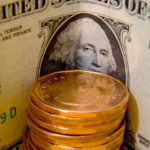The euro traded little changed against the US dollar on Monday, after the signal of the ECB President Mario Draghi that he may act to counter low inflation as soon as next month, divided analysts as the euro zone economy showed signs of strengthening.
EUR/USD hit a session high at 1.3724 at 01:45 GMT, after which the pair trimmed daily gains to trade little changed at 1.3696 by 14:23 GMT, adding 0.02% for the day. Support was likely to be received at February 14th low, 1.3674, while resistance was to be encountered at January 24th high, 1.3738.
While nineteen out of 38 respondents in a Bloomberg Monthly survey expected the ECB President Mario Draghi to ease monetary policy at the next central banks monthly rate-setting meeting in March, the same number predicted the monetary policy will be put on hold.
In its monthly bulletin released last week, the ECB firmly assured that interest rates will be kept at present or even lower levels for a prolonged period of time. The monthly bulletin came in consonance with the main policy statement taken by the central bank President Mario Draghi in the preceding week. Mario Draghi left policy on hold, with the benchmark interest rate unchanged at a record-low 0.25%.
As the central banks main interest rate is already at a record-low 0.25%, there seems to be little room for further cuts. According to those who responded that the ECB may ease monetary policy at its next policy meeting on March 6th, the most likely decisions were seen as end to the sterilization of crisis-era bond purchases or further reduction in the key rate, while less-probable policies were seen as a new offer of long-term loans to banks, a negative deposit rate, a cut in the reserve requirement, changes to the collateral framework for banks, or asset purchases by the ECB.
Mario Draghi is trying to guide the euro zone through fragile economic recovery as inflation remains at the lowest since 2009, but the growth seems to be accelerating in recent quarters. For now, interventions are postponed at least until March, when the central bank is going to publish its quarterly macro-economic forecasts, which will provide first inflation prediction for 2016. Previous forecasts have revealed that the ECB should take more decisive steps and should further ease its monetary policy.
A report by Eurostat, revealed on February 14 that the preliminary gross domestic product of the 18-nation common currency area grew 0.3% in the fourth quarter, compared to the previous quarter, exceeding analysts’ forecasts for a 0.2% increase. The euro zone economy expanded by 0.1% in the three months through September.
On annual basis, the euro zone economy expanded by 0.5% in the fourth quarter, beating analysts’ projections of a 0.4% increase and after a 0.3% drop in the previous quarter.
Meanwhile, official data released on Friday showed, that the index of industrial production, which gauges output in manufacturing, utilities and mining sectors in the United States, decreased 0.3% in January compared to December, marking its first monthly drop since July 2013. Experts had anticipated that industrial production will expand 0.2% in January, after it increased 0.3% in December.
A separate survey, conducted by Thomson Reuters and the University of Michigan, showed that US consumers retained their optimism regarding nation’s economic development in the middle of February. The preliminary reading of the corresponding index of consumer confidence came in at 81.2, which confirmed the final value reported in late January. The median estimate of experts pointed that the index will probably slow down to a reading of 80.5 this month. This data suggested that consumers might be able to increase their spending, after severe winter in January adversely influenced their expenditures.
US markets are to remain closed today due to a federal holiday honoring the birthday of the first President of the country, George Washington.
Elsewhere, USD/JPY hit a session high at 101.99 at 08:15 GMT, after which consolidation followed at 101.93, adding 0.09% for the day. Support was likely to be received at February 6th low, 101.25, while resistance was to be met at February 14th high, 102.41.





